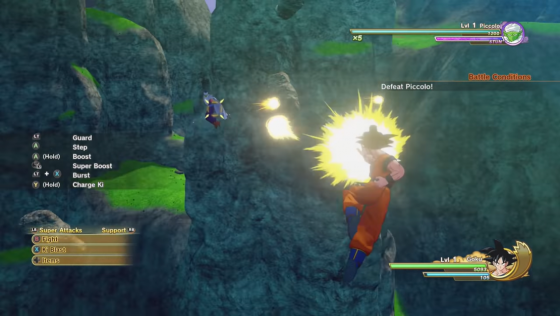
US Gamer
 23rd January 2020
23rd January 2020
Author: Mike Williams
Publisher: Bandai Namco
Machine: PlayStation 4 (US Version)
Another game finally revisits the Legacy of Goku.
Dragon Ball Z: Kakarot: This is Definitely Not Its Final Form
Dragon Ball Z has been a part of my life for a very long time. I'm dating myself, but I remember waiting each month for a VHS full of episodes straight from Japan, untranslated. We'd all gather around in my friend's house and puzzle out what was happening. Even in Japanese, unsubtitled, it was never that hard because Dragon Ball Z is remarkably straightforward. This was before "Dragon, Dragon, rock the dragon...", before Toonami, before DVDs, and before Crunchyroll. Dragon Ball Z has always been there floating in the background.
Dragon Ball Z: Kakarot, an action role-playing game covering a large chunk of the Dragon Ball Z chronology, isn't an entirely new idea. The Legacy of Goku series tried the same concept back in 2002, but it was constrained by being on the Game Boy Advance. Kakarot is a full-fat version, an action RPG retelling Dragon Ball Z lore from the Saiyan Saga all the way to the Buu Saga. It benefits not only from current technology, but also the expertise of CyberConnect2, the team behind all of the Naruto: Ultimate Ninja games.
Kakarot shares DNA with the latter Naruto: Ultimate Ninja Storm games, allowing players to traverse large map representing iconic locations from the franchise, collecting items and completing sidequests from a cadre of colourful side characters. Every location feels like it belongs within the Dragon Ball Z universe, with landmarks like Goku's home, Kame House, the Capsule Corp. headquarters, Red Ribbon Army's Muscle Tower, and King Kai's World.
Whereas the latter Naruto: Ultimate Ninja Storm titles did away with the high-jumping exploration of the Naruto: Ultimate Ninja games and the first Naruto: Ultimate Ninja Storm, Dragon Ball Z: Kakarot allows the Z Warriors to fly freely above each location. You can run along the ground, leap high in the air, take off flying, or even boost at high speeds. There's even a few vehicles you can ride around in, like Goku's Flying Nimbus or a customizable hover car. It's not an open-world per se, instead being comprised of a few large, discrete maps, but it's a wonderful playground within the Dragon Ball universe where you can meet semi-forgotten characters like Eighter, Nam, and Fortuneteller Baba.Flying around the map is a breeze and one of the spots where Dragon Ball Z: Kakarot is at its best. There's a ton to discover around each map, including new items, characters, ore, fishing spots, and campfires, but most of your time will be spent collecting orbs. These orbs are strewn all over every map in plain sight, with the orbs' colours usually having something to do with the location: red orbs near desert areas, blue orbs near water, etc. You need these orbs to progress your characters, but there's a sense of mindless zen to orb collection itself. It's similar to the collection tasks in games like Crackdown and Saints Row 4, where you end up losing yourself in find new spots orbs and maybe a D Metal or two. I flew around collecting orbs for hours before I even knew how to spend them.
You will fight a number of random encounters while exploring each map, though you can boost away in some cases and eventually boost right through the encounters altogether. Combat is generally solid, though having to pull the same moves repeatedly over non-boss fights can start to feel like a straight grind. Combat finds your Z Warrior tethered to their opponents in a 3D arena, with the ability to switch targets with the right stick. You have melee attacks, Ki Blasts, special attacks, a quick dodge, and a block at your disposal, though there are some additional mechanics for those who move beyond button mashing.
There's the Burst attack, which stops enemy attack combos and gives you some space. Vanish Attacks put you behind your foe, and a timed Just Dodge slows time down all gives you chances to really stunt on enemies, though you rarely need to. Fighting properly is a matter of managing your Ki and waiting for the openings in enemy attack patterns. It's not hard, leaning more on making you feel powerful. You'll feel like a badass when you slam an enemy into a mountain and follow up with a Masenko special attack.The problem is fights against random enemies are largely not worth your time. They offer experience to level your characters, but not enough experience to make it worthwhile. Story and side missions offer vastly more experience, making non-boss fights feel more like a nuisance than anything else. In some RPGs, there are spots where you'll just sit and power-level your main or a character who's behind; in Dragon Ball Z: Kakarot, there's little reason to do so. And you don't get the option to skip the fight until you're a certain level above your foes. Even with bonuses from the Training Commmunity Board, story sequences and side quests are the best source for experience.
Bosses run the gamut of being a lot of fun or somewhat tedious. For the most part, they're accurate representations of their animated counterparts, featuring memorable moments and attacks like Zarbon's Shooting Star Arrow or Frieza's Death Ball. Despite some charmingly familiar battles, other times you'll have the fight figured out too quickly and find yourself just whittling a five-layer life bar over the course of several minutes. (Dodoria and his super Armour say "hi".) As you get deeper in, you'll start to see a lot of repeat special attacks with a different name, like the straight charge, the Ki Blast Spam, or the teleport kick, making it feel a bit more like a game than an ongoing contest between godlike beings. Dragon Ball Z: Kakarot flits between fulfilling its vision of allowing you to play memorable Dragon Ball Z fights, and missing the mark.
You're looking at around 40 hours to polish off the story campaign, but the pacing also feels a bit off. Roughly half of Kakarot is comprised of the Saiyan and Frieza Sagas, while in the anime, those are only a third of the nine sagas in total. The story compression also means that some major moments come quickly back-to-back. Chiaotzu's sacrifice, Yamcha's defeat, Piccolo protecting Gohan, and the final fight between Goku and Vegeta happens in around 30 minutes, which lessens the impact. If you're trying out Dragon Ball Z for the first time, I wouldn't start here.These are smaller issues in the face of Dragon Ball Z: Kakarot's progression system. None of it feels particularly well-integrated. There's the leveling issues I spoke of earlier. You fish and collect animal meat-I do love the fact that you punch animals into meat-to cook meals that give you bonuses and lessen the level grinding, but you don't really get a huge benefit from doing so until later on. There's Community Board, which requires you to place Soul Emblems representing familiar Dragon Ball Z characters in different configurations for passive bonuses. But again, it doesn't feel meaningful enough to put in a ton of effort in placement or collecting extra Soul Emblems. The orbs you collect are spent in a Skill Tree to improve your attacks, but some are unlocked through fight challenges or level thresholds.
It adds up to a number of RPG systems that don't feel like they're all working together. They feel like they're around to check off the boxes of an action-RPG, instead of being designed to fit within the Dragon Ball Z universe or Kakarot's gameplay. A lot of the RPG systems are an afterthought.
On PC I also had a few technical problems. For one, characters would seem to slide off into the distance while I was talking to them. There was also some heavy screen-tearing that seemed to be related to V-Sync settings. Yet, the biggest problem on PC is that even without a controller plugged in, the button prompts were all for a non-existent Xbox controller. Kakarot is meant to be played on console it seems.To be clear, I hope there is a sequel for Dragon Ball Z: Kakarot. The concept is sound, and like the Naruto: Ultimate Ninja games, CyberConnect2 is adept at recontextualizing Dragon Ball Z's best moments. But while it's fun seeing the grand tale of Dragon Ball Z retold in this manner, there are a few pacing and gameplay issues. Ultimately, despite being an action-RPG, the RPG side of things is lacking. This is a good start for what I hope is a Kakarot franchise, but it's just the first punch in this fight, not the mighty Spirit Bomb that will finish it off.
Dragon Ball Z: Kakarot distills 291 episodes of Dragon Ball Z down into a 40-hour action-RPG experience. While the pacing is a bit off, seeing the story of Goku and friends told in wide swaths mostly works. The combat also manages to capture the feel of the series in certain boss fights. Unfortunately, the RPG side of things is lacking, with muddy progression, systems that feel useless, and random enemy encounters that can grow tedious. It's a good start, but more training is needed to reach its final form.
Other PlayStation 4 Game Reviews By Mike Williams
Scores
PlayStation 4 Version| Overall | 60% |















